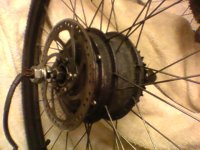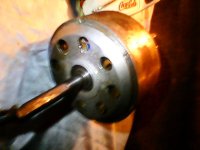Phdintheory
10 mW
hello.
I searched the forum for this, and although it's probably a common question, I wasn't able to find exactly what I need.
I've got a (Liberty I think) somewhat generic Chinese ebike.
I had questions at first concerning my battery setup, but have since created a good 24V power-pack that puts out 25.6V
Although my throttle lights all lit up now, I still didn't feel as if I were getting any kind of assistance to the wheel.
What I would like to do is test the motor directly.
I've removed the wheel from the bike and disconnected the controller and all other wiring.
What I'm left with now is a wheel, with the motor, and a set of wires that come from the motor.
in the set of wires, I have a small wiring connector that holds 5 small thin wires. (red, black, green, blue, and yellow.)
I then have three other wires. All heavier.
One blue, one yellow, and one Green
I tried power Black to blue, and red to green and got a spark! (I fell out of my chair!) lol
So, I don't want to do that again
? If I have the wheel supported so it revolves freely. And have the correct wires, If I directly apply power from the battery pack, should the wheel turn?
Thanks for any help in advance.
Sincerely,
policetac
I searched the forum for this, and although it's probably a common question, I wasn't able to find exactly what I need.
I've got a (Liberty I think) somewhat generic Chinese ebike.
I had questions at first concerning my battery setup, but have since created a good 24V power-pack that puts out 25.6V
Although my throttle lights all lit up now, I still didn't feel as if I were getting any kind of assistance to the wheel.
What I would like to do is test the motor directly.
I've removed the wheel from the bike and disconnected the controller and all other wiring.
What I'm left with now is a wheel, with the motor, and a set of wires that come from the motor.
in the set of wires, I have a small wiring connector that holds 5 small thin wires. (red, black, green, blue, and yellow.)
I then have three other wires. All heavier.
One blue, one yellow, and one Green
I tried power Black to blue, and red to green and got a spark! (I fell out of my chair!) lol
So, I don't want to do that again
? If I have the wheel supported so it revolves freely. And have the correct wires, If I directly apply power from the battery pack, should the wheel turn?
Thanks for any help in advance.
Sincerely,
policetac







